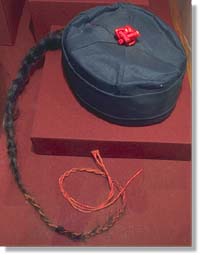  
  
  
  
Law, Order, and Justice for Some - Discrimination

Click icon to hear
Discrimination

Click icon to hear
Discrimination en español


 The
lure of gold promptly made California the most culturally and racially diverse society the
world had ever known - tensions were bound to arise. Benjamín Vicuña MacKenna, a Chilean
noted: San Francisco is a hodgepodge of cities. You can hear all the languages on earth in
its streets: Chinese, Norwegian, Russian, and Polynesian. You can see the garb of all the
nationalities. There are Chinese with belted black pantaloons and blue blouses, with
pigtails down to their knees; a Mexican with his sarape or blanket; the Chilean in his
poncho; a Parisian in his smock; an Irishman with coat and crushed felt hat; and the
Yankee in his red flannel shirt, heavy boots, and trousers belted at the waist. Cultural
diversity remains a Gold Rush legacy. The
lure of gold promptly made California the most culturally and racially diverse society the
world had ever known - tensions were bound to arise. Benjamín Vicuña MacKenna, a Chilean
noted: San Francisco is a hodgepodge of cities. You can hear all the languages on earth in
its streets: Chinese, Norwegian, Russian, and Polynesian. You can see the garb of all the
nationalities. There are Chinese with belted black pantaloons and blue blouses, with
pigtails down to their knees; a Mexican with his sarape or blanket; the Chilean in his
poncho; a Parisian in his smock; an Irishman with coat and crushed felt hat; and the
Yankee in his red flannel shirt, heavy boots, and trousers belted at the waist. Cultural
diversity remains a Gold Rush legacy.
 Prejudice and
discrimination against people of color intensified during the Gold Rush. White 49ers
resented Chinese miners and treated them deplorably. The Chinese were ridiculed in
political cartoons, and assessed Foreign Miners' Taxes. They were physically attacked, and
sometimes had their long, braided hair, called queues, cut off. Prejudice and
discrimination against people of color intensified during the Gold Rush. White 49ers
resented Chinese miners and treated them deplorably. The Chinese were ridiculed in
political cartoons, and assessed Foreign Miners' Taxes. They were physically attacked, and
sometimes had their long, braided hair, called queues, cut off.
Spanish-speaking people were not spared.
The first Foreign Miners' Tax targeted them. The Society of Hounds shamelessly attacked
Chileans in San Francisco.
The Hounds were...nothing but an
organization of soulless wretches whose only object was pillage, robbery and banditry. One
night they attacked Little Chile, a tent community at the foot of Telegraph Hill. They
murdered a mother and assaulted her daughter. - Mariano Vallejo
Deep prejudice against African Americans
remained as well, even though California was admitted to the Union as a free state. Archey
Lee, a slave brought to California by his master in 1857, won his freedom in a landmark
fugitive-slave case when nearly 4,000 free African Americans financed his defense.
In 1855, Reverend Peter Cole spoke out
against such persecution: The Rights of the Negro, or War! We must, we will have it! Our
Destiny is with us! The blood, the wrongs all cry for revenge.
No group of people faced more prejudice
and discrimination than California's native people. In the onslaught of the Gold Rush and
the American settlement, which followed, many Indian tribes were forced from their
ancestral lands. The natural resources they depended upon for food and shelter were
destroyed. Laws were enacted that prevented them from voting, owning property or weapons
of any kind, serving on a jury, or testifying in a court of law. Eventually there were
bounties placed on their heads, and legally-sanctioned massacres of defenseless villages.
The editor of the San Francisco Bulletin spoke for most white Americans: It is a painful
necessity of advancing civilization that the Indians should gradually disappear.
Ultimately, there was an organized
campaign that was explicitly designed to hunt and kill Indians, with bounties placed on
their heads. The expenses of these paramilitary efforts were covered by the federal
government and by the sale of state bonds. By 1866, newspaper articles endorsed the
action. The Chico Courant proclaimed: It has become a question of extermination now. It is
a mercy to the red devils to exterminate them. Treaties are played out. There is only one
kind of treaty that is effective - cold lead. California's Indians very nearly did
disappear. By 1900, their population had been reduced from 300,000 to only 16,000.
Top: Indian
Bounty Bond, Collection of Robert Limacher
Discrimination |